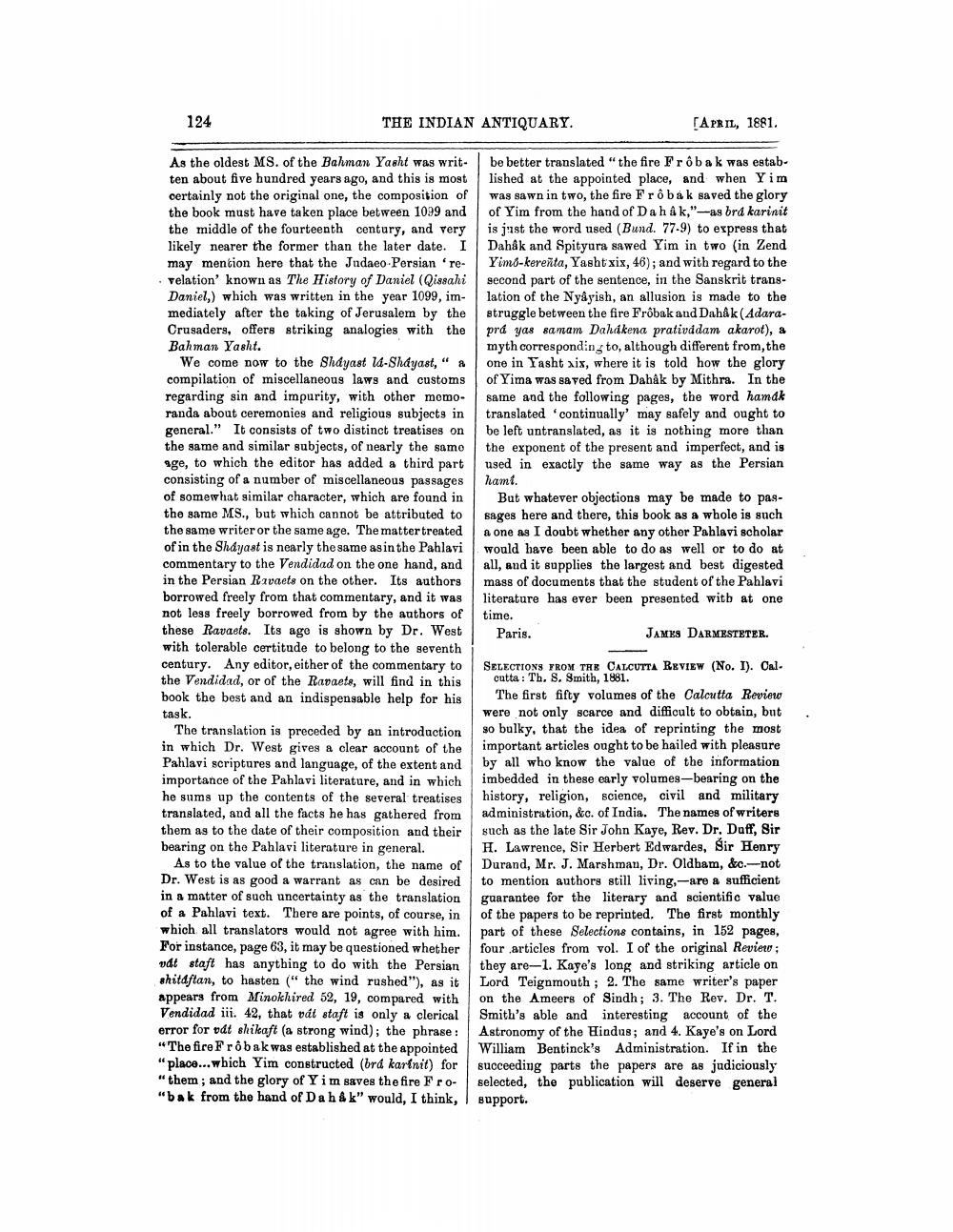________________
124
THE INDIAN ANTIQUARY.
As the oldest MS. of the Bahman Yasht was written about five hundred years ago, and this is most certainly not the original one, the composition of the book must have taken place between 1099 and the middle of the fourteenth century, and very likely nearer the former than the later date. I may mention here that the Judaeo-Persian 'revelation' known as The History of Daniel (Qissahi Daniel,) which was written in the year 1099, immediately after the taking of Jerusalem by the Crusaders, offers striking analogies with the Bahman Yasht.
We come now to the Shayast lá-Sháyast," a compilation of miscellaneous laws and customs regarding sin and impurity, with other memoranda about ceremonies and religious subjects in general." It consists of two distinct treatises on the same and similar subjects, of nearly the same age, to which the editor has added a third part consisting of a number of miscellaneous passages of somewhat similar character, which are found in the same MS., but which cannot be attributed to the same writer or the same age. The matter treated of in the Shayast is nearly the same as in the Pahlavi commentary to the Vendidad on the one hand, and in the Persian Ravaets on the other. Its authors borrowed freely from that commentary, and it was not less freely borrowed from by the authors of these Ravaets. Its age is shown by Dr. West with tolerable certitude to belong to the seventh century. Any editor, either of the commentary to the Vendidad, or of the Ravaets, will find in this book the best and an indispensable help for his
task.
The translation is preceded by an introduction in which Dr. West gives a clear account of the Pahlavi scriptures and language, of the extent and importance of the Pahlavi literature, and in which he sums up the contents of the several treatises translated, and all the facts he has gathered from them as to the date of their composition and their bearing on the Pahlavi literature in general.
As to the value of the translation, the name of Dr. West is as good a warrant as can be desired in a matter of such uncertainty as the translation of a Pahlavi text. There are points, of course, in which all translators would not agree with him. For instance, page 63, it may be questioned whether vát staft has anything to do with the Persian shitdftan, to hasten (" the wind rushed"), as it appears from Minokhired 52, 19, compared with Vendidad iii. 42, that vát staft is only a clerical error for vát shikaft (a strong wind); the phrase: "The fire Frôbak was established at the appointed "place...which Yim constructed (brá kartnit) for "them; and the glory of Y i m saves the fire Fro"bak from the hand of Dah & k" would, I think,
[APRIL, 1881.
be better translated "the fire Frôbak was established at the appointed place, and when Yim was sawn in two, the fire Frô bak saved the glory of Yim from the hand of Da hâk,"-as brá karinit is just the word used (Bund. 77-9) to express that Dahak and Spityura sawed Yim in two (in Zend Yimo-kerenta, Yasht xix, 46); and with regard to the second part of the sentence, in the Sanskrit translation of the Nyâyish, an allusion is made to the struggle between the fire Frôbak and Dah&k (Adaraprá yas samam Dahákena prativádam akarot), a myth corresponding to, although different from, the one in Yasht xix, where it is told how the glory of Yima was saved from Dahâk by Mithra. In the same and the following pages, the word hamak translated 'continually' may safely and ought to be left untranslated, as it is nothing more than the exponent of the present and imperfect, and is used in exactly the same way as the Persian
hami.
But whatever objections may be made to passages here and there, this book as a whole is such a one as I doubt whether any other Pahlavi scholar I would have been able to do as well or to do at all, and it supplies the largest and best digested mass of documents that the student of the Pahlavi literature has ever been presented with at one time. Paris.
JAMES DARMESTETER.
SELECTIONS FROM THE CALCUTTA REVIEW (No. I). Calcutta: Th. S. Smith, 1881.
The first fifty volumes of the Calcutta Review were not only scarce and difficult to obtain, but so bulky, that the idea of reprinting the most important articles ought to be hailed with pleasure by all who know the value of the information imbedded in these early volumes-bearing on the history, religion, science, civil and military administration, &c. of India. The names of writers such as the late Sir John Kaye, Rev. Dr. Duff, Sir H. Lawrence, Sir Herbert Edwardes, Sir Henry Durand, Mr. J. Marshman, Dr. Oldham, &c.-not to mention authors still living,-are a sufficient guarantee for the literary and scientific value of the papers to be reprinted. The first monthly part of these Selections contains, in 152 pages, four articles from vol. I of the original Review; they are-1. Kaye's long and striking article on Lord Teignmouth; 2. The same writer's paper on the Ameers of Sindh; 3. The Rev. Dr. T. Smith's able and interesting account of the Astronomy of the Hindus; and 4. Kaye's on Lord William Bentinck's Administration. If in the succeeding parts the papers are as judiciously selected, the publication will deserve general support.




